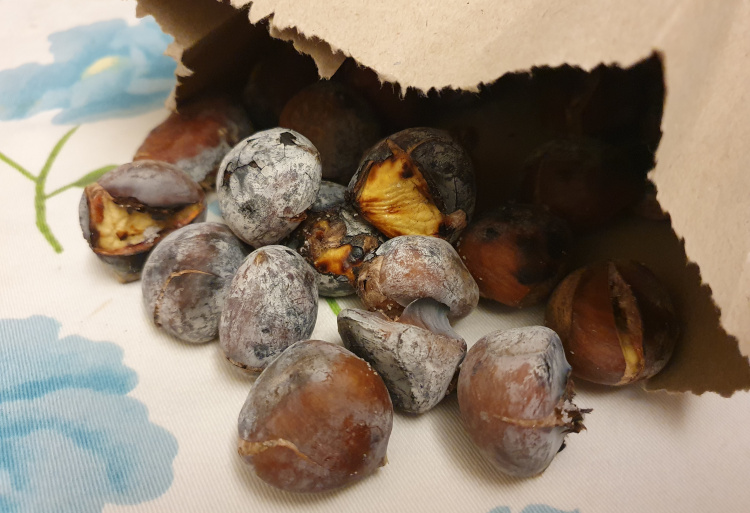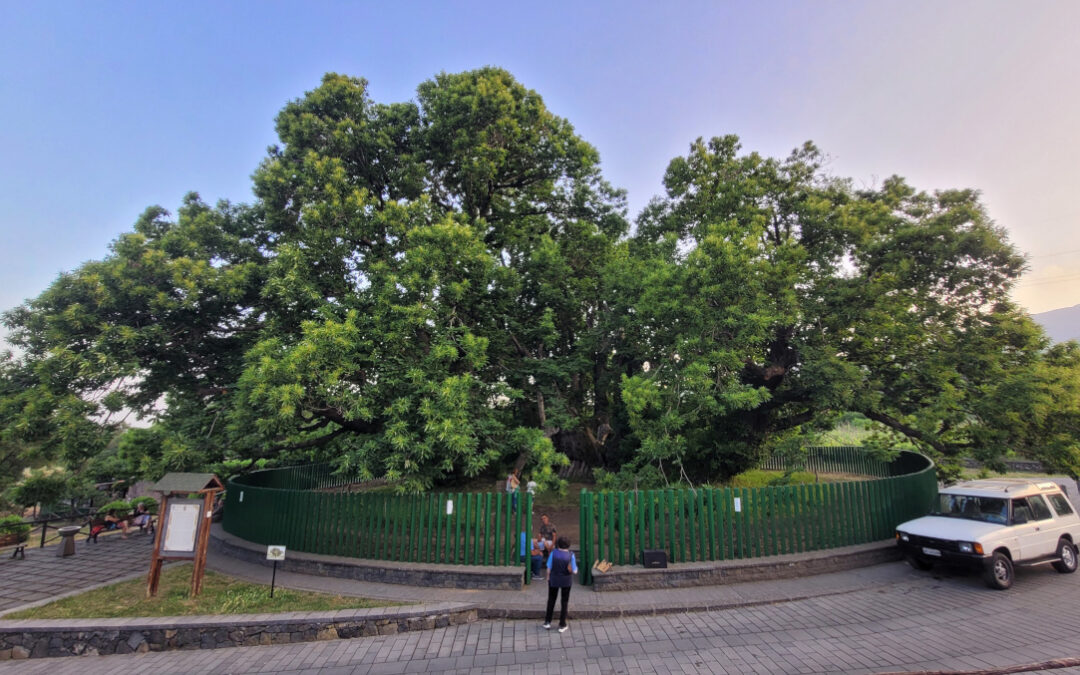On the eastern side of Etna (from the north-east to the south-east) there are – due to the special climate – large occurrences of sweet chestnuts (Castanea sativa).
The chestnuts are edible, but are not grown or collected commercially, as most of them grow in the Etna Park and are therefore protected. In winter, people in Sicily also like to eat roasted chestnuts (in Italian: caldarroste) – but the chestnuts for this usually come from northern Italy.
But there is one Sicilian peculiarity worth mentioning: the roasted chestnuts are white. This is due to the way they are made: the chestnuts are roasted in high, round ovens (about one and a half metres high). Coarse salt is thrown into the embers. The chestnuts lie on top on a perforated base. The steam mixes with the salt, coating the chestnuts in white. The saltiness harmonises wonderfully with the mild and sweet taste of the chestnuts!
By the way, chestnuts are rich in starch and fibre and thus keep you full for a long time! They contain a lot of potassium and vitamin B, but little fat.

But the chestnuts of Etna are used in a different way. They are used to make chestnut honey! In this article we also want to tell you about a very special chestnut tree.
Chestnut honey
Honey has been produced on Etna for a long time. It is called the gold of Etna. The most common varieties are millefiori (flower honey), orange blossom honey, eucalyptus honey and chestnut blossom honey. The Etna village of Zafferana Etnea is particularly famous for its honey production.
Chestnut honey has a dark colour and tastes more tart than other varieties. It is collected in June and July. It is interesting that it remains liquid for a very long time and crystallises only with great difficulty (above 20 ° often not at all). This is due to the fructose content, which is higher in chestnut honey than in other honeys (the more glucose the honey contains, the faster it crystallises).
Chestnut honey is rich in minerals such as potassium and iron and in vitamins B and C. Its anti-inflammatory and antibacterial properties are said to be stronger than those of other honeys.
Try the honey on toast and fresh ricotta made from sheep’s milk!
But now for something different and very special!
Chestnut Tree of a Hundred Horses (Castagno dei Cento Cavalli)
On the eastern slope of Etna, in the village of Sant’Alfio in Etna Park, there is a huge chestnut tree, the Chestnut Tree of 100 Horses (view on Google Maps).
The diameter of its crown is 62 metres, it is 22 metres high, every year in October about 400 kg of chestnuts are harvested.
Its age is estimated at over 3000 years. It is therefore the oldest chestnut tree in the world. A miracle, considering the zone in which it grows: for over 3000 years, this tree has been spared from all earthquakes and lava flows!
But the superlatives go even further: in the Guinness Book of Records, it is listed as the thickest tree in the world. Its trunk circumference is said to be 57.9 metres, the diameter of the trunk 22 metres. However, above the ground, the trunk splits into 3 partial trunks. The entry in the Guinness Book is based on a measurement taken on all three trunks in 1780.
To prove that it is one and the same tree, DNA samples were taken from all three trunks. The results do not contradict this thesis, but further investigations are necessary to prove it conclusively.
Origin of the name
So how did the chestnut tree get its name? A queen is said to have been hunting with 100 knights and their horses when they were suddenly surprised by a thunderstorm. The entire company found refuge under the huge chestnut tree. As the thunderstorm continued into the evening hours, the queen and her entourage (some of the knights are also said to have been her lovers) spent the night there, safe and dry.
It is not entirely clear who this queen is supposed to have been; Joan I of Anjou or Joan of Aragon are often mentioned. However, this story is probably just (well) invented.
History of the tree
The first records of the Castagno dei Cento Cavalli date back to the 16th century. Antonio Filoteo, one of the greatest Sicilian scholars of the 16th century, described the chestnut tree thus: “(a tree) that surpasses in wonders the plants praised by Pliny … and its great trunk, hollowed out by nature, offers shelter to sheep, goats, shepherds and miners. And sometimes a flock of three hundred sheep has been seen under it.”
In the 18th and 19th centuries, the tree was a fixed point on the journeys of many writers and painters through Italy, only Johann Wolfgang von Goethe left it out. He does not mention it in his “Italian Journey”.
In 1965, the noble family who owned the tree and the grounds were expropriated by the Italian state, and the Chestnut Tree of a Hundred Horses was designated a national monument.
In 2021, it was voted Italian tree of the year. It thus represented Italy in the “European tree of the year 2022” competition and was voted 4th.
So this huge tree continues to inspire to this day!
You can visit it around the clock, but it is fenced off. You can only go in during the day.
